|
| |
|
Distant pass |
|
|
| |
|
The ancestor of the oyster appeared at the secondary era, about 190
million years ago. A hundred species of oysters remains today,
living in most of the seas and oceans.
|
|
| |
|
|
|
|
| |
|
|
| |
|
At the Neolithic era, humans used to fish.
Everywhere we found remnants of cooking, we found large
quantities of oyster’s shells.
In China, oysters are cultivated since ancient times. Since
ever, bamboos are cut and put at sea so that oyster larvae fix
on them.
The Romans were great lovers of oysters. It was discovered in
the texts of Pliny the Elder that they had already noticed that
“oysters are better in some places than others”. When Gaul was
conquered, the Romans imported oysters from Brittany.
Next to most of the Roman villas we found piles and piles of
oyster shells. There were pools with sea water everywhere in
Gaul (Clermont, Poitier, Saintes, Jarnac…) on the roads of
oysters which were intended to store the shellfishes when they
travelled to Rome. |
|
|
| |
|
|

| |
|
|
| |
|
In 1698, John LISTER from England was
surprised by the technique used by the French to bring fresh
oysters in Paris: oysters are removed from their shells and are
stacked in baskets of straw, so they arrive ready to be put in
stews.
At the time of Voltaire, oysters were less for food than for
aperitif, so it was not uncommon in the banquets to serve ten or
twelve dozen for each guest as a "mise en bouche"… |
|
|
| |
|
|
| |
|
|
| |
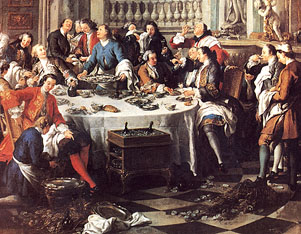
JF de Troy 1727 (Musée Condé, Chantilly) |
|
| |
|
|
| |
|
Birth of modern oyster farming |
|
|
|
| |
|
The wild oysters were extremely abundant on
French shores, especially on the coast of the North Sea and the
Channel. Over time, oyster farming was forgotten and people
simply fished wild oysters. Oyster beds seemed inexhaustible to
such an extent that an order of the king in 1726 to protect
coastal resources, forbade any kind of fishing tool except for
oyster fishing.
Extensive exploitation of oyster beds resulted in the depletion
of the mollusc and in the eighteenth century, royal authority
had, for the first time, to punish abuses. For
a long time, oysters were simply fished from the natural beds
and then stocked over the foreshore (uncovered by the sea at low
tide). St-Vaast la Hougue was one of those sites where oysters
were stored. In 1820, following an intense cold, a fisher lost
almost all the oysters he had parked. When he wanted to get rid
of the empty shells of his dead oysters, he noticed they were
covered with small oysters: he had rediscovered oyster breeding.
In the second half of the nineteenth century, fishing decreased
at the same time as the oyster beds dwindled. Meanwhile oyster
farming was growing.
Until 1963, the breeding of oysters in St-Vaast was on the
floor. The oysters were thrown on the floor and then raked to
pull them out of the sand. New techniques have allowed a
substantial extension of oyster farming. The use of plastic
pockets put onto iron frames was imported from Japan where it
was known since the 30's.
Throughout the last century, there were several attempts to
create new production centres in Normandy, but it is in fact in
the early 70's that there was a boom in this activity.
Today Normandy is the first oyster-producing region in France. |
|
|
| |
|
|
|
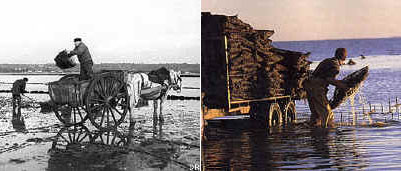
|
|
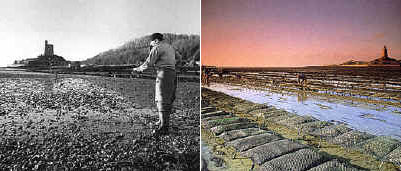
|
|
| |
Origin
of the word |
|
|
| |
|
In ancient Greece, especially in Athens, some
votes were done using oyster shells. The term ostracism comes from
the Greek word ostreon, related to osteon ‘bone’ and ostrakon,
‘shell or tile’. However the word oyster comes from the Latin word
ostrea, which became oistre in Old French and then oyster in
English. |
|
|
| |
|
|
| |
La mangeuse
d'huîtres |
|
|
| |
|
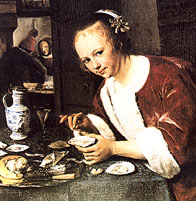
Jan Steen (1625-1679) |
|
|
| |
|
|
| |
Art |
|
|
| |
|
Oyster is a favourite subject for painting
especially in Flemish and Dutch art of the Golden Age. By its
physical appearance but also by the connotations associated with it:
hermetism and hidden complexity, intimacy, pleasure and even
eroticism. Oysters in paintings may suggest the senses and the
erotic tension. |
|
|
| |
|
|
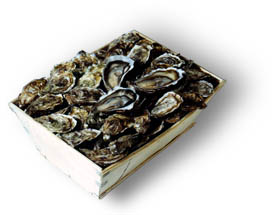
|